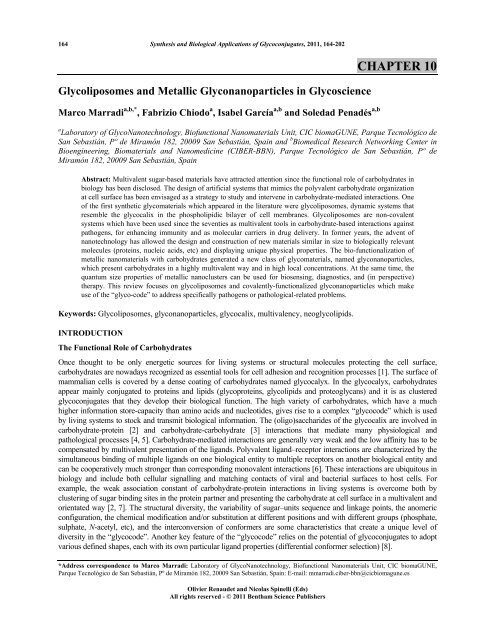chapter 2 - Bentham Science
chapter 2 - Bentham Science
chapter 2 - Bentham Science
You also want an ePaper? Increase the reach of your titles
YUMPU automatically turns print PDFs into web optimized ePapers that Google loves.
164 Synthesis and Biological Applications of Glycoconjugates, 2011, 164-202<br />
Glycoliposomes and Metallic Glyconanoparticles in Glycoscience<br />
Marco Marradi a,b,* , Fabrizio Chiodo a , Isabel García a,b and Soledad Penadés a,b<br />
Olivier Renaudet and Nicolas Spinelli (Eds)<br />
All rights reserved - © 2011 <strong>Bentham</strong> <strong>Science</strong> Publishers<br />
CHAPTER 10<br />
a Laboratory of GlycoNanotechnology, Biofunctional Nanomaterials Unit, CIC biomaGUNE, Parque Tecnológico de<br />
San Sebastián, Pº de Miramón 182, 20009 San Sebastián, Spain and b Biomedical Research Networking Center in<br />
Bioengineering, Biomaterials and Nanomedicine (CIBER-BBN), Parque Tecnológico de San Sebastián, Pº de<br />
Miramón 182, 20009 San Sebastián, Spain<br />
Abstract: Multivalent sugar-based materials have attracted attention since the functional role of carbohydrates in<br />
biology has been disclosed. The design of artificial systems that mimics the polyvalent carbohydrate organization<br />
at cell surface has been envisaged as a strategy to study and intervene in carbohydrate-mediated interactions. One<br />
of the first synthetic glycomaterials which appeared in the literature were glycoliposomes, dynamic systems that<br />
resemble the glycocalix in the phospholipidic bilayer of cell membranes. Glycoliposomes are non-covalent<br />
systems which have been used since the seventies as multivalent tools in carbohydrate-based interactions against<br />
pathogens, for enhancing immunity and as molecular carriers in drug delivery. In former years, the advent of<br />
nanotechnology has allowed the design and construction of new materials similar in size to biologically relevant<br />
molecules (proteins, nucleic acids, etc) and displaying unique physical properties. The bio-functionalization of<br />
metallic nanomaterials with carbohydrates generated a new class of glycomaterials, named glyconanoparticles,<br />
which present carbohydrates in a highly multivalent way and in high local concentrations. At the same time, the<br />
quantum size properties of metallic nanoclusters can be used for biosensing, diagnostics, and (in perspective)<br />
therapy. This review focuses on glycoliposomes and covalently-functionalized glyconanoparticles which make<br />
use of the “glyco-code” to address specifically pathogens or pathological-related problems.<br />
Keywords: Glycoliposomes, glyconanoparticles, glycocalix, multivalency, neoglycolipids.<br />
INTRODUCTION<br />
The Functional Role of Carbohydrates<br />
Once thought to be only energetic sources for living systems or structural molecules protecting the cell surface,<br />
carbohydrates are nowadays recognized as essential tools for cell adhesion and recognition processes [1]. The surface of<br />
mammalian cells is covered by a dense coating of carbohydrates named glycocalyx. In the glycocalyx, carbohydrates<br />
appear mainly conjugated to proteins and lipids (glycoproteins, glycolipids and proteoglycans) and it is as clustered<br />
glycoconjugates that they develop their biological function. The high variety of carbohydrates, which have a much<br />
higher information store-capacity than amino acids and nucleotides, gives rise to a complex “glycocode” which is used<br />
by living systems to stock and transmit biological information. The (oligo)saccharides of the glycocalix are involved in<br />
carbohydrate-protein [2] and carbohydrate-carbohydrate [3] interactions that mediate many physiological and<br />
pathological processes [4, 5]. Carbohydrate-mediated interactions are generally very weak and the low affinity has to be<br />
compensated by multivalent presentation of the ligands. Polyvalent ligand–receptor interactions are characterized by the<br />
simultaneous binding of multiple ligands on one biological entity to multiple receptors on another biological entity and<br />
can be cooperatively much stronger than corresponding monovalent interactions [6]. These interactions are ubiquitous in<br />
biology and include both cellular signalling and matching contacts of viral and bacterial surfaces to host cells. For<br />
example, the weak association constant of carbohydrate-protein interactions in living systems is overcome both by<br />
clustering of sugar binding sites in the protein partner and presenting the carbohydrate at cell surface in a multivalent and<br />
orientated way [2, 7]. The structural diversity, the variability of sugar–units sequence and linkage points, the anomeric<br />
configuration, the chemical modification and/or substitution at different positions and with different groups (phosphate,<br />
sulphate, N-acetyl, etc), and the interconversion of conformers are some characteristics that create a unique level of<br />
diversity in the “glycocode”. Another key feature of the “glycocode” relies on the potential of glycoconjugates to adopt<br />
various defined shapes, each with its own particular ligand properties (differential conformer selection) [8].<br />
*Address correspondence to Marco Marradi: Laboratory of GlycoNanotechnology, Biofunctional Nanomaterials Unit, CIC biomaGUNE,<br />
Parque Tecnológico de San Sebastián, Pº de Miramón 182, 20009 San Sebastián, Spain: E-mail: mmarradi.ciber-bbn@cicbiomagune.es

















